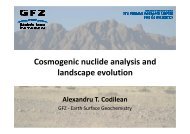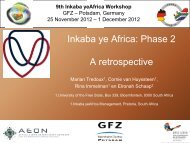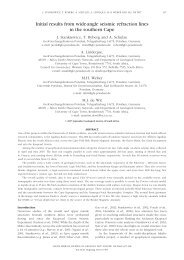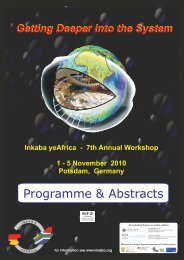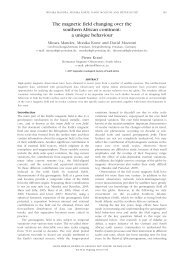South Africa - Inkaba.org
South Africa - Inkaba.org
South Africa - Inkaba.org
You also want an ePaper? Increase the reach of your titles
YUMPU automatically turns print PDFs into web optimized ePapers that Google loves.
New insights on the role of a mantle plume in <strong>South</strong> Atlantic<br />
breakup<br />
R.B. Trumbull, J.K. Keiding, I.V. Veksler<br />
GFZ German Research Centre for Geosciences, Telegrafenberg, 14473 Potsdam, Germany, bobby@gfzpotsdam.de,<br />
jakob@gfz-potsdam.de, ilya.veksler@gfz-potsdam.de<br />
ABSTRACT<br />
There is controversy surrounding the existence and possible role of a deep-seated mantle plume associated with the<br />
Paraná-Etendeka large igneous province. Observational evidence is limited to the erupted and intruded magmatic<br />
rocks of mantle derivation: flood basalts, central complexes and mafic dyke swarms. Key information needed is<br />
pressure-temperature conditions of mantle melting (how hot? how deep?) and composition of primary magmas.<br />
Estimating primary magma compositions from geochemical models based on mineral and rock data is subject to<br />
large uncertainties because rocks are often poor proxies for melt compositions. Preferable is direct analysis of melt<br />
inclusions trapped within early-formed crystals and isolated from the rest of the magma during ascent and eruption.<br />
Here we present data from melt inclusions and host olivines from the Henties Bay-Outjo (HOD) dyke swarm and<br />
Tafelkop lavas in the Etendeka province of NW Namibia. The prime target for this study are dykes of high- MgO<br />
(picritic) compositions, which are thought to be plume-derived, and are therefore of considerable significance for<br />
understanding mantle dynamics and magmatism in this province.<br />
Preliminary microprobe results show that olivines with 85 mol.% forsterite or higher are common in the HOD<br />
dykes, while olivine in the lavas analyzed are less magnesian (Fo78 or lower). We reconfirmed extremely Mg-rich<br />
olivines (up to Fo93.4) that were reported by Thompson and Gibson (2000) from SW of the Brandberg Complex,<br />
and we have discovered more localities with exceptionally Mg-rich olivines (up to Fo93.6), so the distribution of<br />
such high-Mg olivines appears to be larger than previously thought. Most olivines with Fo >85 are too Mg-rich to<br />
be in equilibrium with the whole-rock composition, indicating that the grains are entrained xenocrysts which<br />
crystallized from an earlier, much more magnesian melts.<br />
Most important is the finding that melt inclusions are abundant in the xenocrysts with Fo > 90, so we have access<br />
to melt compositions from which these enigmatic olivines formed. The inclusions range in size from 10-70<br />
microns, are typically round in shape and are partly or completely crystallized, with Al-rich clinopyroxene , Al-rich<br />
orthopyroxene, and spinel (chromite). Trapped melts are tholeiitic picritic basalts with maximum 17.5 wt. % MgO.<br />
Olivine-melt themometry using these compositions yields estimates of mantle potential temperature of 1520°, in<br />
contrast to the 1700°C proposed by Thompson et al. (2000) based on whole-rock models and more in line with<br />
petrologic estimates for plume temperatures in Hawaii and Iceland. Further analysis of trace element compositions<br />
from these inclusions will give potentially important information on magma type and mantle source composition.<br />
Reference: Thompson, R. N. & Gibson, S. A. (2000). Transient high temperatures in mantle plume heads inferred<br />
from magnesian olivines in Phanerozoic picrites. Nature 407, 502-506<br />
KEYWORDS: Etendeka Province, mantle temperature, olivine, melt inclusions<br />
80



